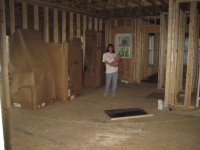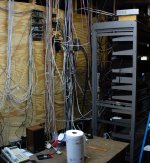Good drywall and pipe advice! We did no glue, all screwed on drywall. Our plumber, the worst sub on our house, taped the glue and "primer" cans together with duct tape to avoid the temptation of not using primer. Given his lack of attention to detail and quality, it's a good idea.
One little thing I did was put a cut off valve for the refrigerator in the basement where I had easy and quick access. Standard protocol is to put the silly small valve behind the fridge, but then you have to roll it out to get to it. If you have hard wood floors, the cost reduced small wheels on the fridge will leave a mark (we had to roll ours around on 1/8" luon (sp?) board used for tile).
Put hose bib connections on each deck so you can wash them off.
Silly AC wiring things we did: You can get AC outlets at the box stores that have a built-in night light (LED based). So we have outlets in halls that you don't need outlets by code, but they are there for these automatic night lights. The hall outlets are also great for vacuum cleaning, since you don't have to go into a room to find an outlet. Also put an outlet or two in the master bath for this function.
If you have a room that might be or become a home office, be sure to add two more circuits. One for a laser printer, laminator, or other high current device and one for the coffee maker.
You're kitchen layout with boxes is great! We did that too. Now think about what appliances are on the counters and see if you need to have a few extra circuits. We have one area where there is a coffee maker, toaster oven, microwave above in the cabinet, and an outlet for a waffle maker. This is all in 6' of counter space, and your electrician will never think to put 4 circuits in a tight space like this.
Enclosed are pictures that show that I know about going nuts with wiring, and have thought about security when you have cats.
In our previous house, I wired every window. It was very time consuming and nerve racking when drilling the holes for the plungers. The current house has Anderson windows, and it looked even harder to work them. So I tried a different approach. I have all my interior doors wired with magnetic sensors, the plunger type you can't see. You you don't need to do all, but here's the thinking. I'm more concerned with someone breaking in when I'm gone than the whole place going nuts if someone breaks in while I'm there. So think about your house layout and a bad guy looking around. Are some some doors he'd have to open, like closet doors or doors to rooms you'd normally have closed? If so, then wire them. I also have all outside doors wired and the automation system announces when they open.
A lot of this comes down to if the bad guy will break a window or door to get in, if he'll break into an occupied house, and if when he's in (when you're gone) he will not open any closed door. Think about if you're away for a few days, is there an interior door the bad guy would have to open that you could leave closed and would work with the cats.
I also have a driveway sensor so if the bad guys come down the driveway anytime, I hear about it. Eddie Walker has a post going on that one. The combination of the driveway sensor and wiring just doors works good for me. You two need to talk about just what security is, and if the TV image of the bad guy breaking into the house in the middle of the day and the alarm goes nuts is realistic for your rural situation, or if you'd be happy to just know when doors are opened and when someone comes down the driveway.
We ran 18 gauge pair to a lot of rooms for in ceiling speakers. There are also good in wall speakers. Automation and alarm systems talk, and if you have enough speakers in the house you are not relying on a poor quality speaker in the cheap alarm console/panel on the wall. Leave a coil of 3' of wire against a stud or run wires between studs so you can grab it and it won't be trapped by the drywall. Take measurements and pictures so you can go back later and find them. You can add the speakers anytime. Suggested rooms are garage, just inside garage, kitchen, room you watch TV in, master bedroom, master bath, basement, shop. We did every room, but that's the overkill talkin'.
If this sounds good, I'll post how I did the interior doors and in particular how to work with the trades so they are not inconvenienced.
Other random low voltage ideas, if any sound interesting post and I'll elaborate:
I always ran 3 CAT5 when I ran any. Ethernet, Phone, Future. Same pull, just one or two more boxes of wire.
Simple satellite receiver needs 1 coax, digital recording type need 2, if you want off air or surveillance monitors add add another coax. I put an antennae in the attic with amplifier on it's own 18 guage DC power line (not using the coax).
Where you have a TV, put 2.5" conduit up to a box where the TV will hang. You may also want to put in boxes for speakers.
We have his and hers DVRs. We ran the HDMI to the TV in the TV room, and then ran 3 matched length coaxes to the bedroom for the component input on that TV. Also ran a coax for off air/surveillance. A cat5 for audio, a cat5 for the IR repeater, and a cat5 for TVs that can do Ethernet. Result is you can watch your satellite or recorded shows from either the TV room or the master bedroom with just one DVR.
I ran a cat5 to the laundry near the washer, behind the fridge with ice maker and under the dishwasher so I can have a water leak detectors.
Ran a cat5 to the attic for a heat sensor so I can tell if the attic is on fire.
Run cat5 to where you want alarm system panels.
Run cat5 to outside doors for doorbell and put in box. That way you can switch to a door phone to talk to who's there.
Everywhere I ran a video and power for surveillance, I ran a cat5 because in a few years the cost of the high def cameras will come down.
We put in a few places in the ceiling for smoke detectors. We have all of the "required by code" ones, and wanted some additional independent low voltage ones for the automation/alarm system. So we have smoke or heat detectors in the kitchen, shop, garage, office and above the dryer.
We put a few motion detectors in the ceilings for controlling lighting, more on the lighting in a second. On this and the smoke detectors, you can just put a round cover plate on for now while you're in the "fog of construction".
In a central part of the house, possibly in a closet, run two cat5's and put in an outlet. If you want, add another cat5 (same pull, just one more wire) for smoke or heat detector in case the WiFi catches fire. We did this and have the wireless router for the house in there. One cat5 is for ethernet for wired computers, the other for the DSL line. This just hides a nice piece of infrastructure. My work shop and tractor garage also have their own WiFi boxes.
Figure out where your satellite dish will go and put the 1.5" conduit out there now while you can dig things up or get in walls. If it's going on the side of the house, you can run the conduit there and prepare an area to bolt the dish too and run a #6 ground wire. Otherwise, the installer will do the "screw it to the roof" in which case the satellite dish isn't the only thing that gets screwed.:laughing:
In the kitchen, master bedroom, and by the deck doors we had the electrician put in one more gang worth of box. Then you put in a orange divider and you can add a push button or two for things down the road such as a panic or all lights on function. Avoids cluttering up the wall with lots of boxes.
One last topic: lighting. You can retrofit lighting control, but it cost about $80 to $125 per switch to do so, and $80 for the controller to AC connection. We wanted some lights that could be turned on by the security/automation system, such as some outdoor flood lights, some hall lights, the garage lights, and a sconce light in the main room. We also did each bedroom, but that's back to overkill. Now here's what we did for the control. We ran a 14-3 from the switch box that had the wire that went to the actual light bulb to a double gang box in a closet (so we had access to it but didn't have to look at it). In the switch box, we connected black to the AC power. Red went to the light bulb, and white went to the switch contact that would normally go to the light bulb. In the closet where the 14-3 came in the top of the double gang box, we wire nuted the red and white together (the white had a red tape on it so it wouldn't be confused with neutral). We put a wire nut cap on the black. This box also had a 18 gauge pair that came in the bottom of the box to run a single pole double throw relay (SPDT). I have a little circuit board for that which includes a metal shield to keep the high and low voltage separate. So the house wiring works all the time, and you can add a 12V relay that connects to your alarm/automation system later and control some lights. When I explained all this to the inspector, he was OK with it all.
All this together with an alarm controller gives you system functionality like:
When you open the garage doors into the house, lights come on in the garage and house.
When someone comes down the drive, the outside flood lights go on.
When you open the front door, outside and inside lights come on.
When you have a fire or panic, lights come on.
With motion detector, when you walk down the hall lights come on.
Use as many colors of cat5 as you can, you can order far more colors than the box store has. Label every wire as you pull it! When you plan all this, buy a few cans of different colored spray paint and hit where you'll put all these boxes. That way you can walk through the house and think about your design and you won't forget things when you doing the actual wiring.
I've left some advanced ideas out, but this post is too long as it is. Yell if you want more data or pictures.
Pete



